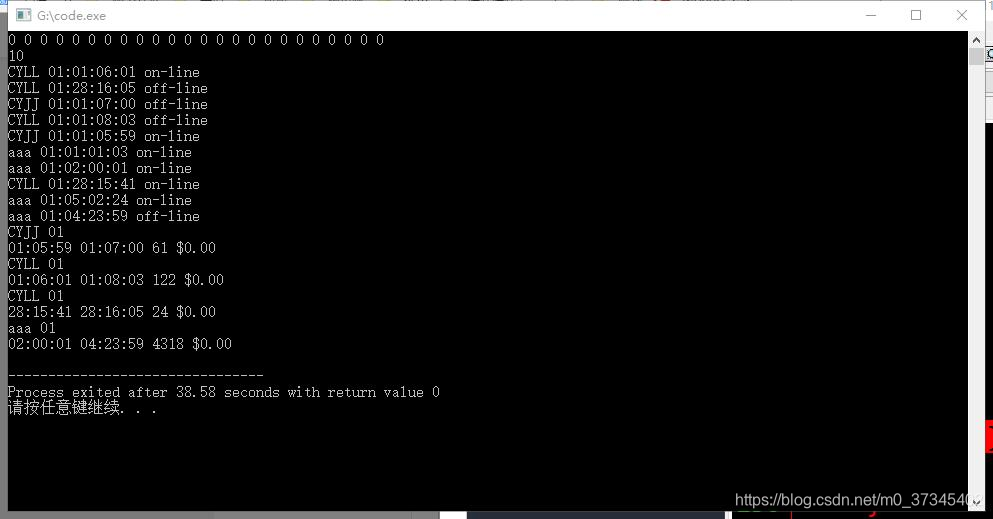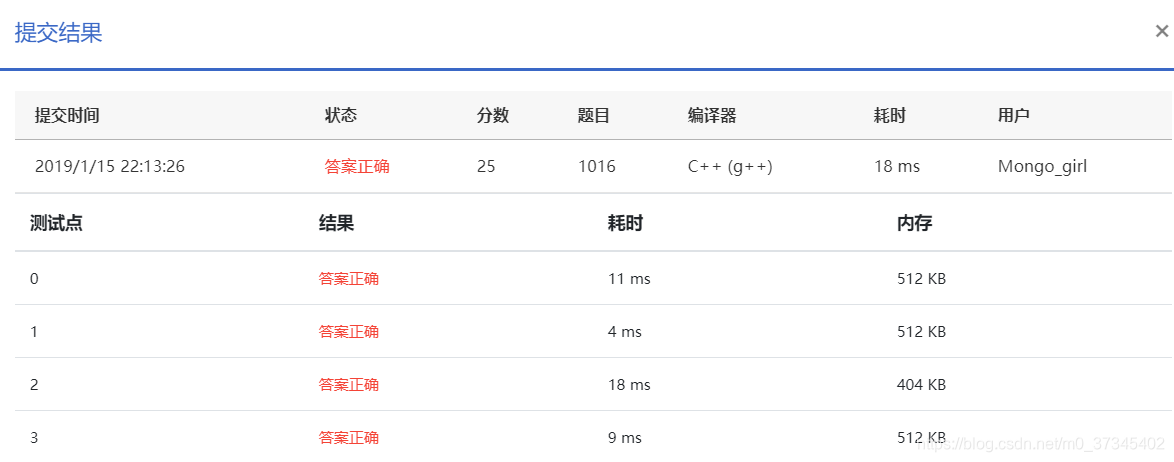题目链接:https://pintia.cn/problem-sets/994805342720868352/problems/994805493648703488
A long-distance telephone company charges its customers by the following rules:
Making a long-distance call costs a certain amount per minute, depending on the time of day when the call is made. When a customer starts connecting a long-distance call, the time will be recorded, and so will be the time when the customer hangs up the phone. Every calendar month, a bill is sent to the customer for each minute called (at a rate determined by the time of day). Your job is to prepare the bills for each month, given a set of phone call records.
Input Specification:
Each input file contains one test case. Each case has two parts: the rate structure, and the phone call records.
The rate structure consists of a line with 24 non-negative integers denoting the toll (cents/minute) from 00:00 - 01:00, the toll from 01:00 - 02:00, and so on for each hour in the day.
The next line contains a positive number N (≤1000), followed by N lines of records. Each phone call record consists of the name of the customer (string of up to 20 characters without space), the time and date (mm:dd:hh:mm), and the word on-line or off-line.
For each test case, all dates will be within a single month. Each on-line record is paired with the chronologically next record for the same customer provided it is an off-line record. Any on-line records that are not paired with an off-line record are ignored, as are off-line records not paired with an on-line record. It is guaranteed that at least one call is well paired in the input. You may assume that no two records for the same customer have the same time. Times are recorded using a 24-hour clock.
Output Specification:
For each test case, you must print a phone bill for each customer.
Bills must be printed in alphabetical order of customers' names. For each customer, first print in a line the name of the customer and the month of the bill in the format shown by the sample. Then for each time period of a call, print in one line the beginning and ending time and date (dd:hh:mm), the lasting time (in minute) and the charge of the call. The calls must be listed in chronological order. Finally, print the total charge for the month in the format shown by the sample.
Sample Input:
10 10 10 10 10 10 20 20 20 15 15 15 15 15 15 15 20 30 20 15 15 10 10 10
10
CYLL 01:01:06:01 on-line
CYLL 01:28:16:05 off-line
CYJJ 01:01:07:00 off-line
CYLL 01:01:08:03 off-line
CYJJ 01:01:05:59 on-line
aaa 01:01:01:03 on-line
aaa 01:02:00:01 on-line
CYLL 01:28:15:41 on-line
aaa 01:05:02:24 on-line
aaa 01:04:23:59 off-line
Sample Output:
CYJJ 01
01:05:59 01:07:00 61 $12.10
Total amount: $12.10
CYLL 01
01:06:01 01:08:03 122 $24.40
28:15:41 28:16:05 24 $3.85
Total amount: $28.25
aaa 01
02:00:01 04:23:59 4318 $638.80
Total amount: $638.80:题意 给出每个小时的按分钟计费的每分钟的费用,给出一些通话记录,包括名字、时间(月:日:时:分)、在线状态。
输出每段通话记录的开始和结束时间,通话时间,此段时间的费用,以及每个人所有通话记录的总费用。
:思路 模拟:判断是否在同一天,如果在不在同一天,进行模拟。如果在同一天,再看是否为同一小时。
如果某一行通话记录为0元,则不输出total amount,另起一行,

#include<iostream>
#include<algorithm>
using namespace std;
double fig[25];
double pre[111];
struct node{
string name;
char mon[3];
int day,hour,min;
int sta;
}p[1111];
bool cmp(node a,node b){
if(a.name!=b.name) return a.name<b.name;
if(a.day!=b.day) return a.day<b.day;
if(a.hour!=b.hour) return a.hour<b.hour;
return a.min<b.min;
}
void print(int x){
if(p[x].day<10){
cout<<"0"<<p[x].day<<":";
}else{
cout<<p[x].day<<":";
}
if(p[x].hour<10){
cout<<"0"<<p[x].hour<<":";
}else{
cout<<p[x].hour<<":";
}
if(p[x].min<10){
cout<<"0"<<p[x].min;
}else{
cout<<p[x].min;
}
}
int main(){
for(int i=0;i<24;i++){
cin>>fig[i];
}
//求前缀和
pre[0]=fig[0];
for(int i=1;i<24;i++){
pre[i]=pre[i-1]+fig[i];
}
int n;
cin>>n;
char s[11];
for(int i=0;i<n;i++){
cin>>p[i].name;
cin>>s;
p[i].mon[0]=s[0];
p[i].mon[1]=s[1];
p[i].mon[2]='\0';
p[i].day=(s[3]-'0')*10+(s[4]-'0');
p[i].hour=(s[6]-'0')*10+(s[7]-'0');
p[i].min=(s[9]-'0')*10+(s[10]-'0');
cin>>s;
if(s[1]=='n'){
p[i].sta=1;
}else{
p[i].sta=2;
}
}
sort(p,p+n,cmp);
double ans=0.0;
for(int i=0;i<n-1;i++){
if(i==0){
ans=0;
}
else if(p[i].name!=p[i-1].name){
if(ans!=0){
cout<<"Total amount: $";
printf("%.2lf\n",ans/100);
}
ans=0;
}
double sum=0.0;
int time=0;
if(p[i].name==p[i+1].name&&p[i].sta==1&&p[i+1].sta==2){
if(ans==0){
cout<<p[i].name<<" "<<p[i].mon<<endl;
}
if(p[i].day<p[i+1].day){
sum+=(p[i+1].day-p[i].day-1)*pre[23]*60;
time+=(p[i+1].day-p[i].day-1)*24*60;
sum+=(pre[23]-pre[p[i].hour])*60;
time+=(23-p[i].hour)*60;
sum+=(60-p[i].min)*fig[p[i].hour];
time+=60-p[i].min;
if(p[i+1].hour!=0){
sum+=pre[p[i+1].hour-1]*60;
time+=p[i+1].hour*60;
}
sum+=p[i+1].min*fig[p[i+1].hour];
time+=p[i+1].min;
ans+=sum;
print(i);
cout<<" ";
print(i+1);
cout<<" ";
cout<<time<<" "<<"$";
printf("%.2lf\n",sum/100);
}else{
if(p[i].hour!=p[i+1].hour){
sum+=(pre[p[i+1].hour-1]-pre[p[i].hour])*60;
time=(p[i+1].hour-p[i].hour-1)*60;
sum+=(60-p[i].min)*fig[p[i].hour];
time+=60-p[i].min;
sum+=p[i+1].min*fig[p[i+1].hour];
time+=p[i+1].min;
ans+=sum;
print(i);
cout<<" ";
print(i+1);
cout<<" ";
cout<<time<<" "<<"$";
printf("%.2lf\n",sum/100);
}else{
sum+=(p[i+1].min-p[i].min)*fig[p[i].hour];
time+=p[i+1].min-p[i].min;
ans+=sum;
print(i);
cout<<" ";
print(i+1);
cout<<" ";
cout<<time<<" "<<"$";
printf("%.2lf\n",sum/100);
}
}
}
}
if(ans!=0){
cout<<"Total amount: $";
printf("%.2lf\n",ans/100);
}
return 0;
}
写了一个晚上...感谢水水





 本文介绍了一种模拟电话计费系统的实现方法,根据每小时的费率结构和详细的通话记录,计算每位客户的总费用。通过比较通话记录的时间戳,确定通话时段,计算费用。
本文介绍了一种模拟电话计费系统的实现方法,根据每小时的费率结构和详细的通话记录,计算每位客户的总费用。通过比较通话记录的时间戳,确定通话时段,计算费用。
















 428
428

 被折叠的 条评论
为什么被折叠?
被折叠的 条评论
为什么被折叠?








